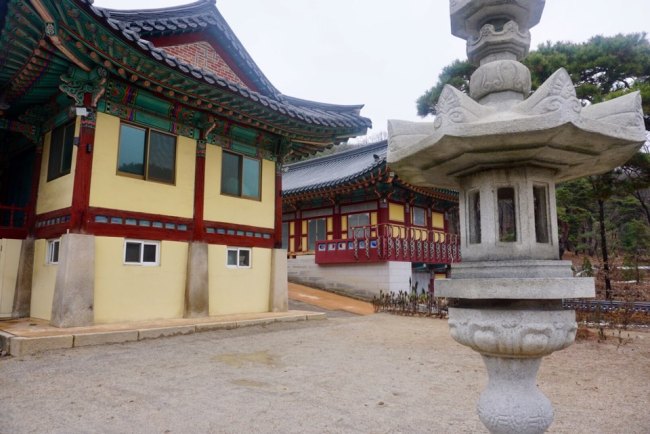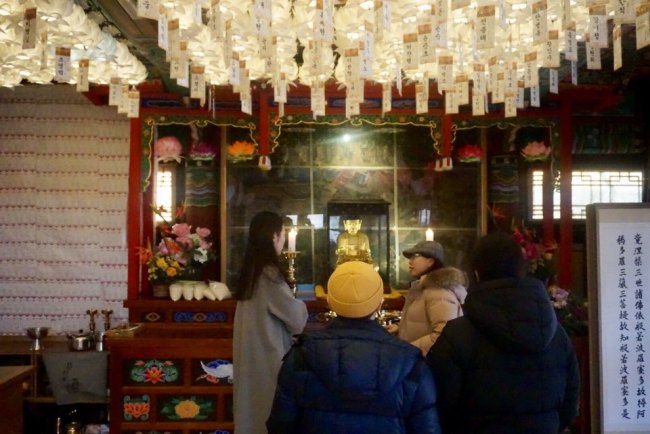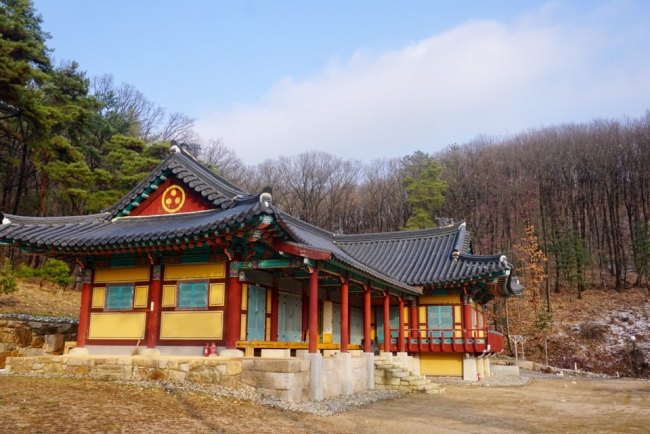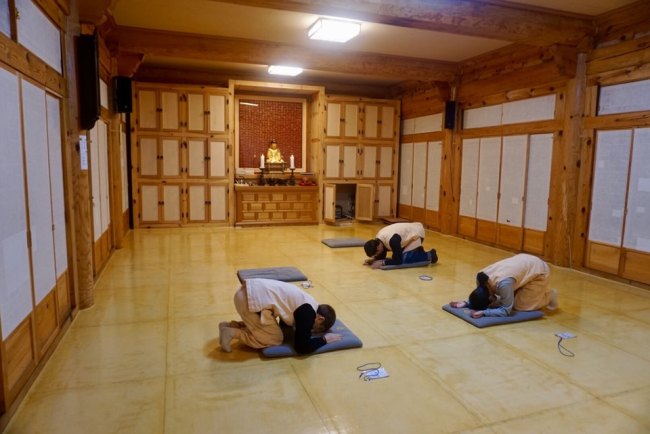Buddhist temples are religious places, but temple stays offer participants a chance to look into themselves and find inner peace, regardless of their religion.
For a one-day inner journey, I recently headed out to Heungguksa, located on the mountain ridges of Nogosan in Goyang, Gyeonggi Province, an hour drive northwest of central Seoul.
 |
Heungguksa (By Im Eun-byel / The Korea Herald) |
Because the trip was rather short, I was not expecting much seclusion. Compared to other temples, Heungguksa is much more accessible. It is near Seoul and visitors can drive up the mountain.
But climbing the steep staircase from Iljumun, the entrance gate of the temple, to the main courtyard, I was immediately immersed in a peaceful, monastic atmosphere.
Heungguksa is surrounded by a pristine forest, which completely blocks all traces of the bustling city. Past the eaves of the temple buildings, the snow-covered mountain tops of Bukhansan created a serene atmosphere.
To get into the Buddhist mood, I put on clothes prepared by the temple -- a top and pants with a subdued orange hue. Getting out of my tight jeans, I already felt more relaxed.
The one-day stay started out with a simple historic tour. A cultural heritage commentator from Goyang City took the participants around the temple.
According to commentator Jeon Mi-rae, famed Shilla-era monk Wonhyo -- known throughout Korea -- had the temple built in 661, sensing the strong energy stemming from the area.
“Since Heungguksa has been renovated, it is not fully appreciated for its cultural heritage value, but still, the temple holds much history,” Jeon told the participants. “The place is rich with history.”
 |
Cultural heritage commentator Jeon Mi-rae explains about a Buddha statue at Heungguksa to templestay participants. (By Im Eun-byel / The Korea Herald) |
After the 45-minute class, the four participants moved on to a talk with a monk at a separate building for temple stays. The building houses a prayer room and residences for visitors. The floor was warmly heated.
 |
A separate building for templestay at Heungguksa (By Im Eun-byel / The Korea Herald) |
One of the participants was a 30-year-old office worker. He came to the temple to experience Buddhist culture out of curiosity. Two others were 20-year-old college students, who were interested in Buddhism as a religion. And there was me.
Greeting the participants, monk Jungmook, in charge of Heungguksa Templestay, started to talk about who we are as human-beings.
“Our ego is like a dazzling pearl. It is clear like a pearl, without any color. But situations and environments paint the pearl, giving us personalities and characteristics,” Monk Jungmook said, teaching the participants how to assemble beads for making danju, wrist beads for prayer.
“It is hard to understand that everyone feels and understands situations differently. That is why we are mad at each other, forgetting that we are all different people,” he said.
After the talk, the participants gathered around a table for a monastic meal. The food was simple, made with everyday vegetables with as few condiments as possible.
Before sharing the meal, the monk instructed the participants to read out a phrase written on the wall. Nonetheless, the phrase was not a Buddhist prayer, but a simple reflection on how we should appreciate every meal.
The highlight of the one-day Buddhism experience was 108 bae (bowing). Listening to a tape, participants made 108 bows over the course of 33 minutes.
The tape was not a prayer record. Along with the sound of moktak, a traditional wooden instrument used in temples, a peaceful male voice read out phrases which could be meaningful to non-Buddhists, such as “Try to stay humble,” “Be gracious of what we have” and “Do not be greedy.”
Though the practice did not seem like a much of an exercise at first -- as it is done in a slow pace -- I could feel the blood rushing through my head. Blood was circulating from the top to the bottom of my body.
 |
Templestay participants make 108-bae (By Im Eun-byel / The Korea Herald) |
After 108 bae, the monk told the participants, “You have finished the journey. You are now ready to climb down to the world.”
Though the legs started to ache when heading down from the temple, I could feel the warmth inside me. The four-hour stay brought unexpected energy inside me.
While fresh air filled my lungs, my head was cleaned out -- leaving more room for thoughts.
By Im Eun-byel (
silverstar@heraldcorp.com)







![[Today’s K-pop] Blackpink’s Jennie, Lisa invited to Coachella as solo acts](http://res.heraldm.com/phpwas/restmb_idxmake.php?idx=644&simg=/content/image/2024/11/21/20241121050099_0.jpg)



